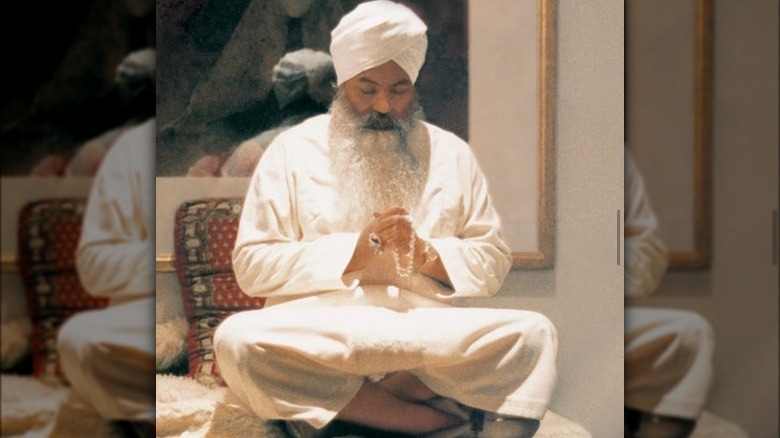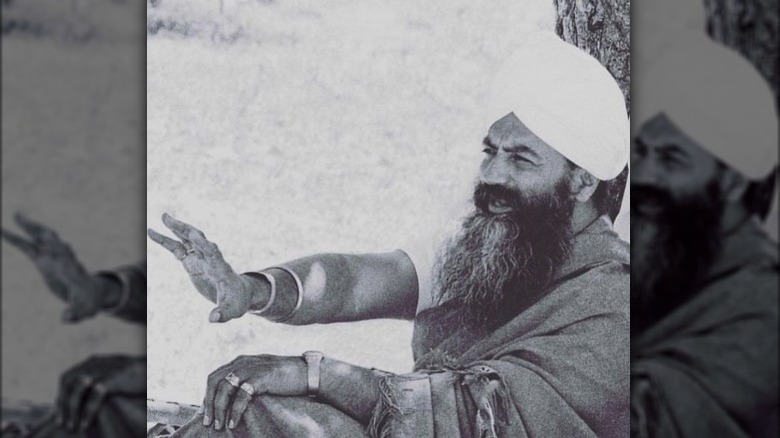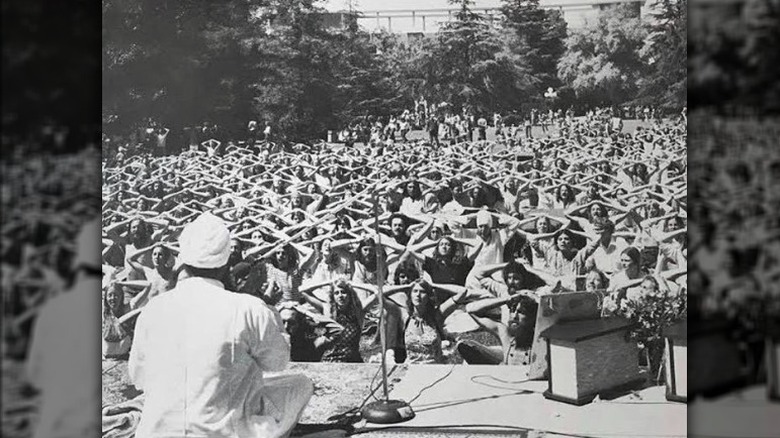The Disturbing History Of Yogi Tea's Founder
TRIGGER WARNING: This article contains potentially distressing material. Instances of sexual assault, abuse, and child mistreatment are mentioned. Tasting Table acknowledges that it may be difficult to engage with this content and encourages you to click away if needed.
From foie gras to a politically-charged crusade against pasta, even the world of food and beverage can court controversy.
According to the Yogi Tea website, the brand subscribes to the Ayurvedic tradition, an ancient healing philosophy that promotes food as medicine. Yogi brand tea was named after its founder, Harbhajan Singh Khalsa — aka Siri Singh Sahib or, as he's most commonly known, Yogi Bhajan. Bhajan is most famous for popularizing Kundalini yoga, a holistic practice focused on movement and concentration as a pathway to achieving altered consciousness. And from this practice blossomed the 3HO Foundation (which stands for happy, healthy, and whole), a multi-pronged organization that promotes its philosophy and practice, providing guides and even soundtracks for yogic meditation. Few could've predicted Yogi Bhajan's ascendancy, going from teaching small groups at a Los Angeles antique store to sharing company with the Dalai Lama and Indira Gandhi. The state of New Mexico, Yogi Bhajan's longtime home, even honored him by flying the flags in front of government buildings at half mast following his passing in 2004.
But now, years later, former followers are speaking up about their experience with the guru — and from their accounts, it was anything but enlightened.
The hope of New Age Spirituality
Bhajan came to Los Angeles from New Delhi in 1968. During this time, many young adults horrified by the Vietnam War and/or disillusioned by the counterculture's "peace and love" rhetoric turned to Western ideology to seek answers (or, at minimum, a little of that peace). In the retrospective preface to his collection of oral teachings, "Grist for the Mill," Yogi Ram Dass reflects, "In the first half of the seventies, spiritual growth rooted in Eastern mysticism was definitely 'in.' There was a proliferation of spiritual teachers (most often self-proclaimed gurus) with sizable followings ... At their root was a genuine yearning to connect with a deeper context from which to lead a life of greater consciousness and equanimity."
It seems that the original idea that started it all — kundalini yoga — began pure enough and has surely had lasting beneficial impacts on followers. But in the case of Bhajan, manipulation and abuse of power took over.
Godlike status as a veil
Many were enraptured by this novel New Age Spirituality, and Bhajan convinced his followers to give up their birth names and sever ties with anyone outside of the 3HO community. Bhajan arranged marriages between members and came to establish 3HO-run schools in India and New Mexico, to which followers were coerced to send their children. According to recent allegations, these schools were a breeding ground for lice, disease, extreme physical punishments, gross neglect, squalid living conditions, malnutrition, and other nightmares. At one point, the schools enacted an exercise meant to cultivate "non-attachment," in which children and young teens were rehomed to total strangers. A group of former students (now adults) are actively enacting a civil lawsuit against the school for child sexual abuse in a Los Angeles Superior Court.
Yogi Bhajan, despite his dictate for followers, had no such interest in non-attachment. Although kundalini yoga champions spiritual enlightenment, Bhajan had a taste for lavish material goods. He was known to frequent many Beverly Hills shops, came to live on a sprawling estate, and collected jewelry and expensive cars.
Bhajan was openly misogynistic, forcing his female staff to wear matching white dresses and turbans, and he even explicitly advocated that marital rape and battery are acceptable. Given the weight of accounts, the rap sheet of sexual assault against his adult and child followers (while professing that he was celibate and monogamous to his wife) have only gotten longer with time.
Mindful consumerism and the end of an era
The spiritual leader come pious mogul wove 3HO into a web of interconnected enterprises, which protected him and others from decades worth of abusive deeds. And as those that have suffered under his hands have told their stories, folks have come to regard Bhajan differently. Bhajan's old stomping grounds, Yoga West in New Mexico, took down the placards with his quotations from studio walls, and many modern Kundalini practitioners are calling for his name to be removed from textbooks. Bahi Sahib Satpal Singh Khalsa (a Sikh Dharma leader who is married to Bhajan's daughter) proposes not throwing out the baby with the bathwater, saying to The Santa Fe New Mexican, "If he had a dark side, that should not negate the fact of all the good."
In many ways, Bhajan's brainchild has taken on a life of his own; Kundalini Yoga has influenced people's lives in a way that has nothing to do with Bhajan the man. After all, people have been practicing Kundalini meditation since it was first outlined in the Hindu Upanishads around 800 B.C.E. But, now, Kundalini practitioners and Yogi Tea drinkers are faced with the conundrum that conscious consumers encounter all too often: Is it possible to separate the art from the artist?
If you or someone you know is dealing with spiritual abuse, you can call the National Domestic Violence Hotline at 1−800−799−7233. You can also find information, resources, and support on their website.



